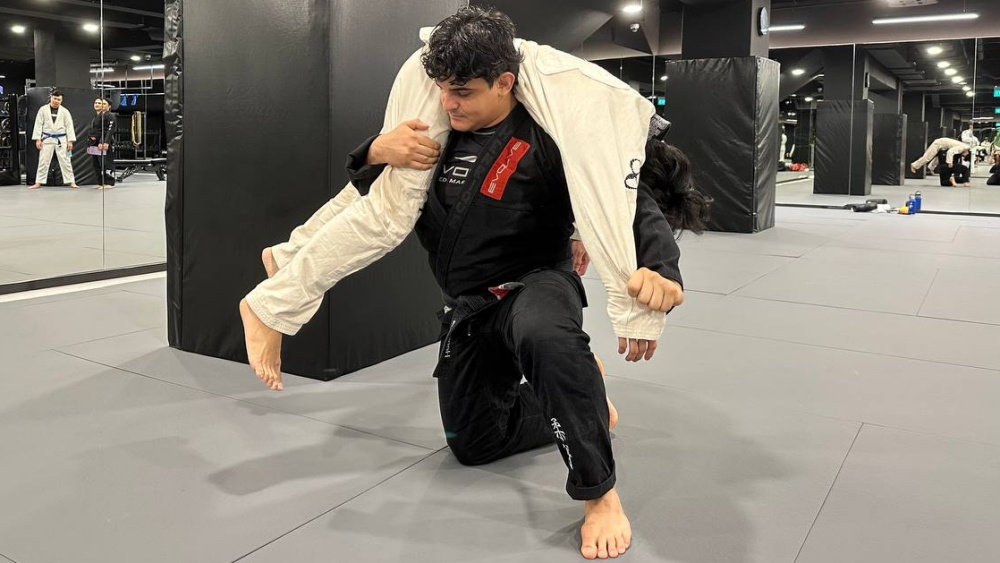The underhook is an aspect part of grappling in BJJ. It is a hold that gives a strategic advantage by enabling strong control over an opponent and, at the same time, a good spot for offensive and defensive transitions. However, knowing that many practitioners frequently go for the underhook in various positions creates opportunities for counterattacks. Understanding how to leverage these opportunities effectively can elevate your game immensely. In today’s article, we explore several ways to attack and counter the underhook from 3 common positions.
1) Top Spin Counter For The Top-Side Control
In top-side control, when your opponent secures an underhook, a solid and effective counter is the top spin. To execute this, first secure control of their hips or far shoulder to stabilize their movement. As they try to leverage the underhook to bridge or escape, quickly pivot around their head, spinning 180 degrees over their body. This movement not only breaks their underhook but also transitions you to the other side of their body, maintaining top control and potentially catching them off-guard.
Building on the top spin counter, you can transition directly into a back take as you move to the opposite side of their body. After completing the spin, focus on establishing a chest-to-back connection as soon as you see an opening. As you settle into position, ensure that you keep yourself attached to the opponent’s back and proceed with attacking the neck. This technique flows smoothly from the initial technique and is a recommended alternative when the opportunity presents itself.
2) Underhook Repummel & Kimura From The Top Half Guard
If your opponent obtains an underhook in the half guard, immediately work to pummel your arm inside. This move involves sliding your underhooked arm deeper and flipping it inside, turning the underhook into an overhook for them. This regains your control in the clinch and prevents them from using the underhook to off-balance (Kuzushi) or sweep you. Once you establish your underhook, you can use it to pressure their shoulder down, flattening them onto the mat, which is advantageous for passing the guard.
From the half guard, another effective counter to an opponent’s underhook is transitioning to a kimura on the underhooked arm. As they secure the underhook, use your free arm to control their wrist and slide your underhooked arm over their shoulder to grip your own wrist, locking in the kimura grip. This not only counters the underhook but also puts significant pressure on their shoulder, leading to a potential submission or forcing them to abandon their underhook to defend against the kimura.
3) Overhook Uchi Mata & Sumi Gaeshi From The Standing Position
When you’re both standing, and your opponent gets an underhook, counter it by securing an overhook on the same side. With the overhook in place, step your outside leg across their body to align your hips closely with theirs. This positioning sets you up for the uchi mata, a classic throw typically seen in Judo. Sweep your inside leg against their thigh, lifting and using the momentum to flip them over. This technique uses their underhook against them, leveraging your overhook for the throw.
Alternatively, you can employ the sumi gaeshi to counter the underhook. Start from the same entry as the last technique. To set up the sumi gaeshi, maintain the overhook and position your free hand behind their thigh or belt. Drop your hips lower than theirs while pulling them forward over your center of gravity. Execute the throw by lifting with the hand behind the thigh and tipping them over your hips, using the overhook to maintain control and follow through to the ground. This technique effectively uses the leverage of the overhook to counter the underhook, flipping your opponent backward and allowing you to transition to a dominant ground position.
The Importance of Drilling
Drilling is a fundamental aspect of grappling (and martial arts in general) that cannot be overstated. It is through repetitive practice that muscle memory is developed, allowing techniques to be executed smoothly and instinctively during live sparring or competition. Drilling counter techniques to the underhook ensures that you can react swiftly and effectively when an opponent attempts to gain an advantage using this common grappling position.
Consistent drilling helps you recognize the position and feel more comfortable and confident in your response. Each rep should focus on the nuances of the movement, such as hand placement, hip movement, and the like – ensuring that every detail is taken into account. This attention to detail makes the difference between a technique that is barely functional and one that is highly effective.
To truly integrate these counters into your skill set, practice them in varying scenarios that mimic live-match conditions. This includes drilling with partners of different sizes and skill levels, under fatigue, and with varying levels of resistance. Scenario-based drilling helps adapt your responses to real-world situations, enhancing your ability to use these techniques fluidly and effectively in a match.
Integration into Your Existing Game

The ultimate goal of learning new techniques is to incorporate them seamlessly into your existing game. This requires not only understanding and practicing the moves themselves but also knowing when and how to apply them during live situations. Evaluate your current grappling style and strategies to identify where these counters can best complement your strengths and shore up weaknesses. By doing this, you can find scenarios where you can include these techniques effectively.
Understanding and practicing these counter-techniques enhances your defensive skill set in BJJ in many ways. Learning how to effectively neutralize an opponent’s underhook is a skill that will stay with you even up to the black belt level. Each technique shown not only counters the underhook but also creates opportunities for you to transition to offensive positions or submissions. Training these counters under expert supervision in a controlled environment is crucial to ensure proper execution and optimize safety. We hope you enjoyed today’s article and keep on training!
You may also like:
















